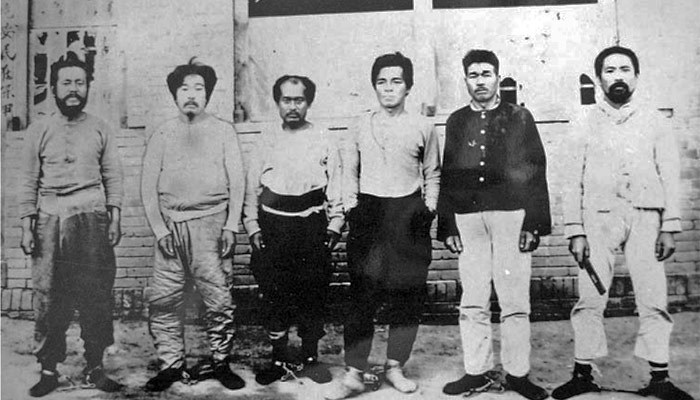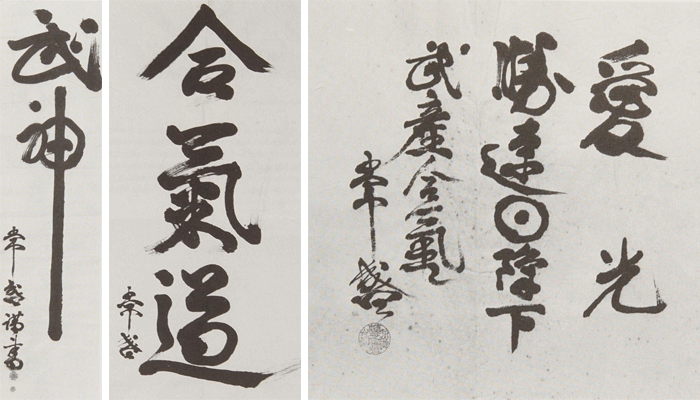
O-Sensei’s Aliases: Moritaka and Tsunemori Ueshiba
Beyond his birth name Morihei Ueshiba 植芝盛平, O-Sensei used two other names, Moritaka Ueshiba 植芝守高 and Tsunemori Ueshiba 植芝常盛, during his lifetime.
Moritaka Ueshiba was a name that Ueshiba often used in his 40s and 50s after his trip to Mongolia in 1924. The journey to Mongolia took place approximately three years after the First Omoto-kyo Incident, during which Japanese authorities suppressed Omoto-kyo by raiding their headquarters and arresting its leader, Onisaburo Deguchi 出口 王仁三郎. Deguchi, along with a group of his disciples, including Ueshiba, embarked on an expedition to Mongolia with the ambition of establishing a new religious kingdom there. The Omoto-kyo believes in Bankyo Dokon 万教同根, the concept that all religions share the same root and, thus, the unity of all religions is essential. This idea resonated with other religious groups in China and Korea, motivating Deguchi to undertake the trip. They first arrived in Hoten, China, before proceeding to Mongolia. During this time, Deguchi assumed the Chinese name Wang Wen Xiang, while Ueshiba was known as Wang Shou Gao 王守高.
The group formed an alliance with Lu Zhan kui 盧占魁, a Manchurian officer and bandit leader, who aimed to establish the “Northwest Autonomous Army” with the approval of Zhang Zuo Lin 張作霖, a warlord backed by Japan who ruled Manchuria 満州 from 1916 to 1928. Initially, Lu’s recruitment efforts saw some success, and he later renamed his army the “All Mongolia Independence Army.” However, this move quickly drew suspicion from Zhang.

The group narrowly escaped the firing squad in Mongolia. Deguchi and Ueshiba are the second and the third from the left.
Ultimately, the journey to Mongolia ended in failure. The group, along with Lu’s army, was surrounded and arrested. While Lu and his men faced execution by firing squad, Deguchi and Ueshiba were saved at the last minute due to the intervention of the Japanese consul. They were released into the custody of the Japanese consul and later repatriated to Japan. Ueshiba seemed to develop a fondness for the name Shou Gao, pronounced as Moritaka in Japanese, and continued using it for a long time.
Tsunemori Ueshiba was another name that Ueshiba used in much of his Shodo 書道 (Japanese calligraphy) work. He had a profound interest in Shodo, which began through one of his top students, Seiseki Abe 阿部醒石. Before meeting Ueshiba at an Osaka dojo in 1952 and starting Aikido training, Abe had been practicing calligraphy for almost 20 years. In 1954, two years after their first meeting, Abe accompanied Ueshiba to Shingu 新宮 for the opening of a new dojo, and they stayed there for a month. Knowing Abe was a Shodo Teacher, Ueshiba asked him to teach calligraphy in between Aikido classes. As Ueshiba observed Abe’s teachings, he gradually became more interested in the art.
According to an interview with Abe conducted by Stanley Pranin, the first calligraphy Ueshiba created was the characters “aiki” 合氣. Being Abe’s Aikido teacher, it would be odd for Ueshiba to call Abe a teacher. Nevertheless, he often visited Abe’s home to practice Shodo, where a special room was set aside for him. This unique teacher-student relationship continued until Ueshiba’s passing. Over the years, Ueshiba regularly traveled to Osaka to teach Aikido while staying at Abe’s home to learn Shodo. The stone carving of Aiki Jinja outside the Aiki shrine in Iwama was authored by Abe.

Some of Ueshiba’s calligraphy work signed with the name Tsunemori
Abe believed that both Aikido and Shodo share the same essence, which is kokyu 呼吸, only manifesting in different forms. Shodo and Aikido shared a harmonious connection, their integration allowed Ueshiba to express his philosophical and spiritual beliefs through the art of calligraphy. In the later stages of his life, Ueshiba produced numerous calligraphy pieces, often using the name Tsunemori 常盛 as his signature. Nevertheless, the origin of this name is unknown.
Author’s Note: We appreciate your readership! This article serves as a preliminary introduction to the subject matter. While we aim for accuracy, we cannot guarantee the content’s precision and it may contain elements of speculation. We strongly advise you to pursue additional research if this topic piques your interest. Begin your AikidoDiscovery adventure! 🙂





3 Comments
Bjorn Saw
Tsunemori 常盛
常 means “always, usual, regular.”
1. Always, Forever – This refers to something that will never change.
2. Usual, Regular – This refers to something that is normal or expected.
3. Flag – This refers to a flag with the sun, moon, or dragon drawn on it, which was used by the emperor.
4. Unit of Length – This refers to a unit of length that is twice the length of a jin (eight feet).
盛 means “to heap up, to pile up, to serve (food) generously.”
1. To fill a container – To fill a container with something, such as food or liquid.
2. To pile up high – To stack something in a high pile.
3. Offerings to the gods – Items offered to the gods as a form of worship.
4. Vigorous – Having a lot of energy or enthusiasm.
5. To enliven – To make something more lively or exciting.
6. To compound medicine – To mix and prepare medicine for consumption.
7. Mating season – The period of time when animals are sexually active.
Bjorn Saw
Moritaka 守高
守 means “protect, defend, obey.”
1. Protect, Guard – To protect or guard someone or something.
2. Endure – To be able to withstand or bear something.
3. Maintain – To keep something in a certain state or condition.
4. Watch, Observe – To keep an eye on something and not let it out of sight.
5. Shelter, Shield – To provide protection or safety.
6. Defend, Fortify – To prepare or equip for defense.
7. Governor – A local or regional official in charge of a district or group.
8. Amulet – A charm or object believed to bring good luck or protection.
9. Caretaker – Someone who looks after or takes care of someone or something.
高 means “high, tall.”
1. High – Used to describe physical height, position, status, or rank.
2. Excellent – Used to describe a high grade or level.
3. Famous – Used to describe someone or something that is well-known.
4. Increase – Used to describe something that is rising or becoming higher.
5. Respect – Used to show respect for someone’s actions or words.
6. Arrogant – Used to describe someone who is overly proud or haughty.
7. Amount – Used to describe a quantity or degree.
AikidoDiscovery Admin
Hi Bjorn, thank you so much for sharing this additional information! Your input is greatly appreciated.